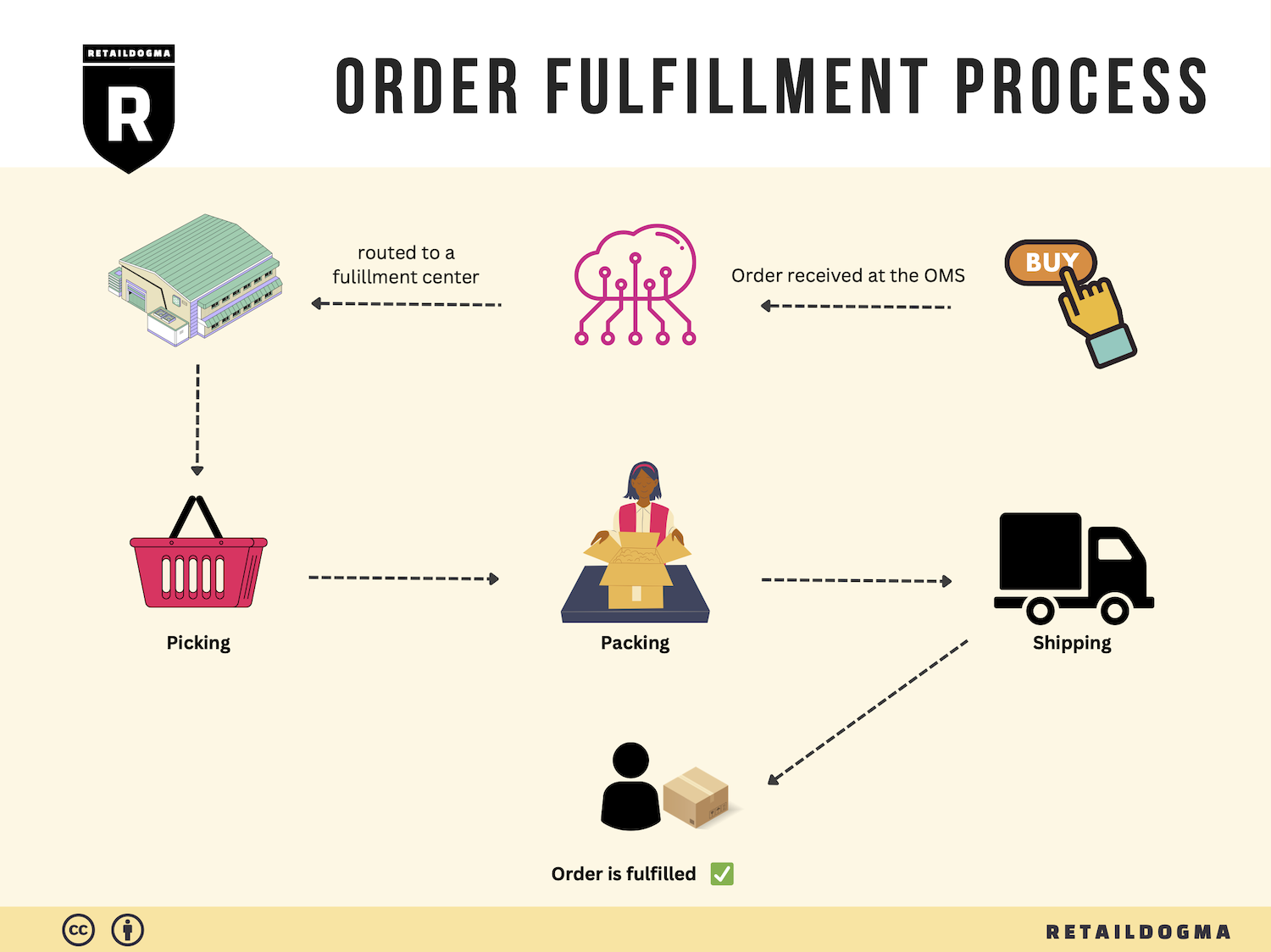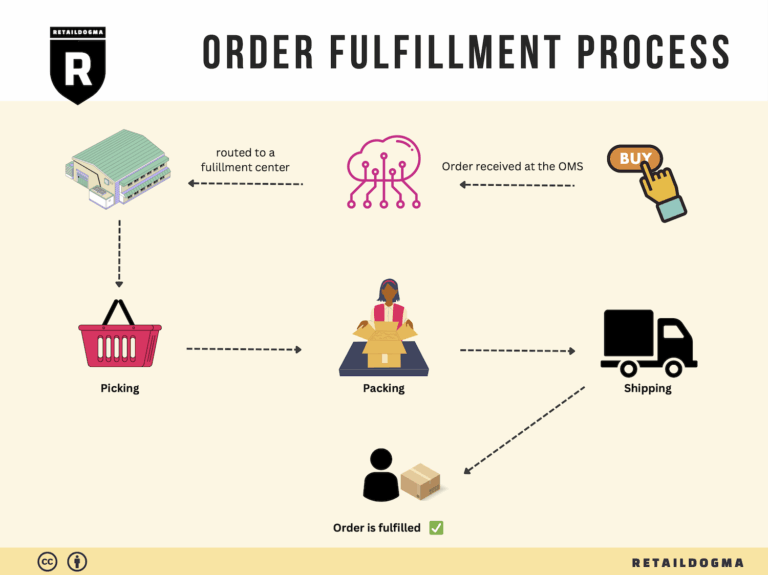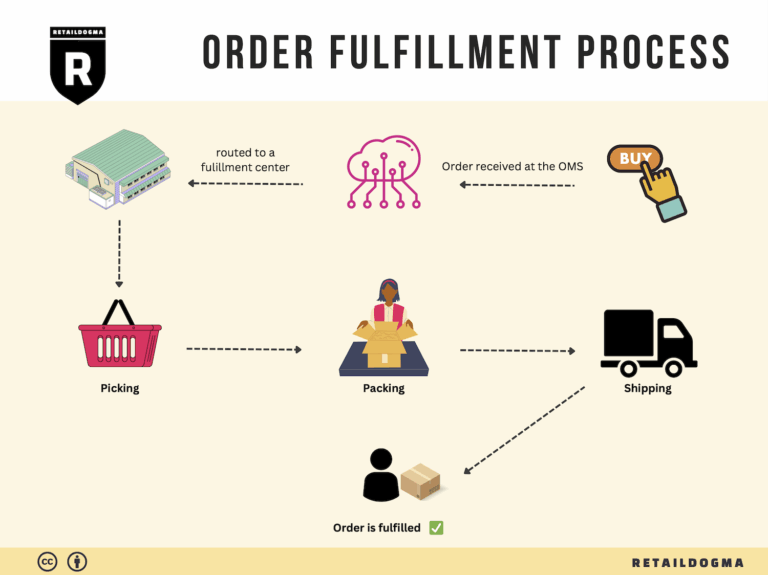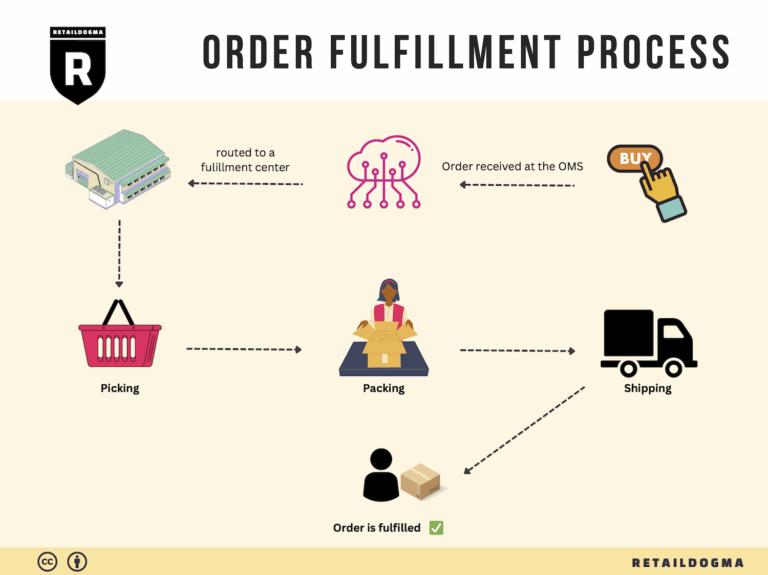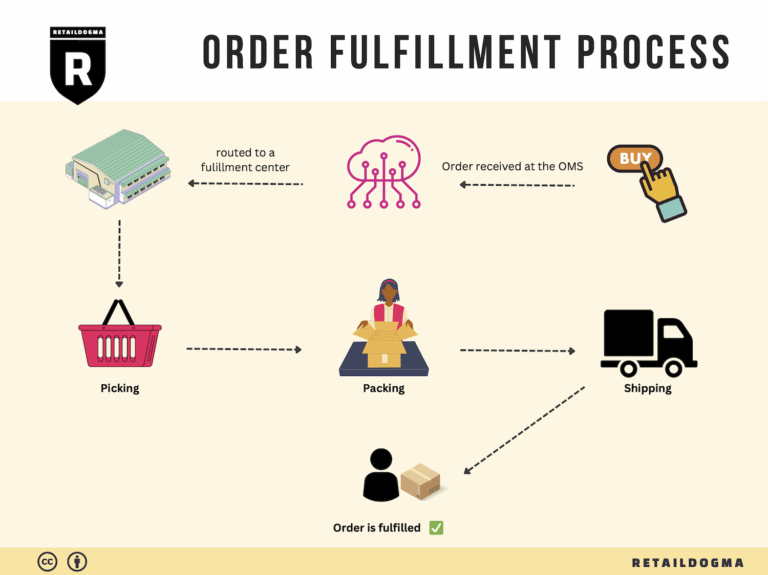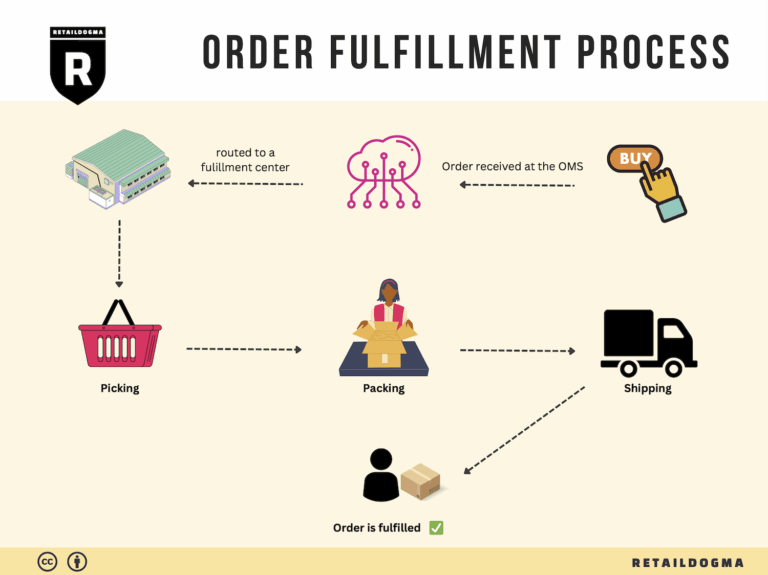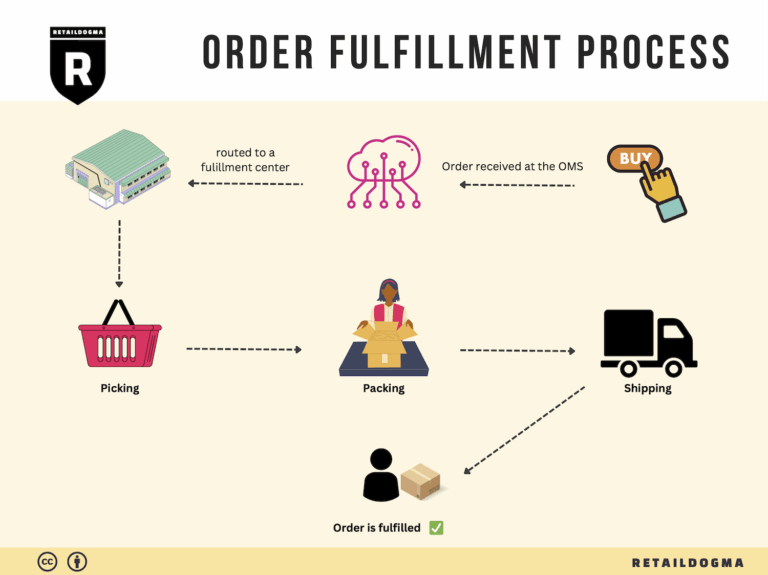How Order Fulfillment Works: A Step-by-Step Guide for Businesses
What is E-commerce Fulfillment? An Introduction for Growing Businesses
Understanding E-commerce Fulfillment: A Key to Scaling Your Business
As your online business begins to gain traction, you may find yourself overwhelmed with the logistics of packing and shipping orders. This growing pain is common for many entrepreneurs who transition from small-scale operations to more significant sales volumes. The fulfillment process—essentially the series of steps involved in getting a product to a customer—can quickly become a bottleneck if not managed effectively.
E-commerce fulfillment encompasses everything from inventory management and order processing to packaging and shipping. When done right, it ensures that your customers receive their products on time and in perfect condition, leading to happier clients and repeat business. However, as sales surge, the complexities of fulfillment can escalate, diverting your focus from growth and innovation to daily logistics challenges.
In this guide, we will demystify e-commerce fulfillment by covering several critical aspects that every growing business should consider. First, we will explore various fulfillment models, including Third-Party Logistics (3PL) and Fulfillment by Amazon (FBA), highlighting their advantages and disadvantages. Understanding these options will help you make informed decisions about which model aligns best with your business needs.
Next, we’ll delve into the core services associated with e-commerce fulfillment, such as inventory management, order processing, kitting, assembly, and returns management. By grasping these services, you’ll be better equipped to evaluate potential fulfillment partners.
Choosing the right fulfillment partner is crucial for long-term success. We will provide guidance on what to look for in a fulfillment provider, including their track record, technology capabilities, and customer service. This section will help you identify partners who can scale with your business while maintaining high standards of accuracy and reliability.
Lastly, we will address the often-overlooked topic of pricing. Understanding the costs associated with different fulfillment options will empower you to make strategic financial decisions that support your growth ambitions.
The goal of this guide is to empower you with the knowledge needed to navigate the complexities of logistics and fulfillment confidently. By making informed choices about your fulfillment strategy, you can focus on what truly matters: growing your business and delighting your customers.
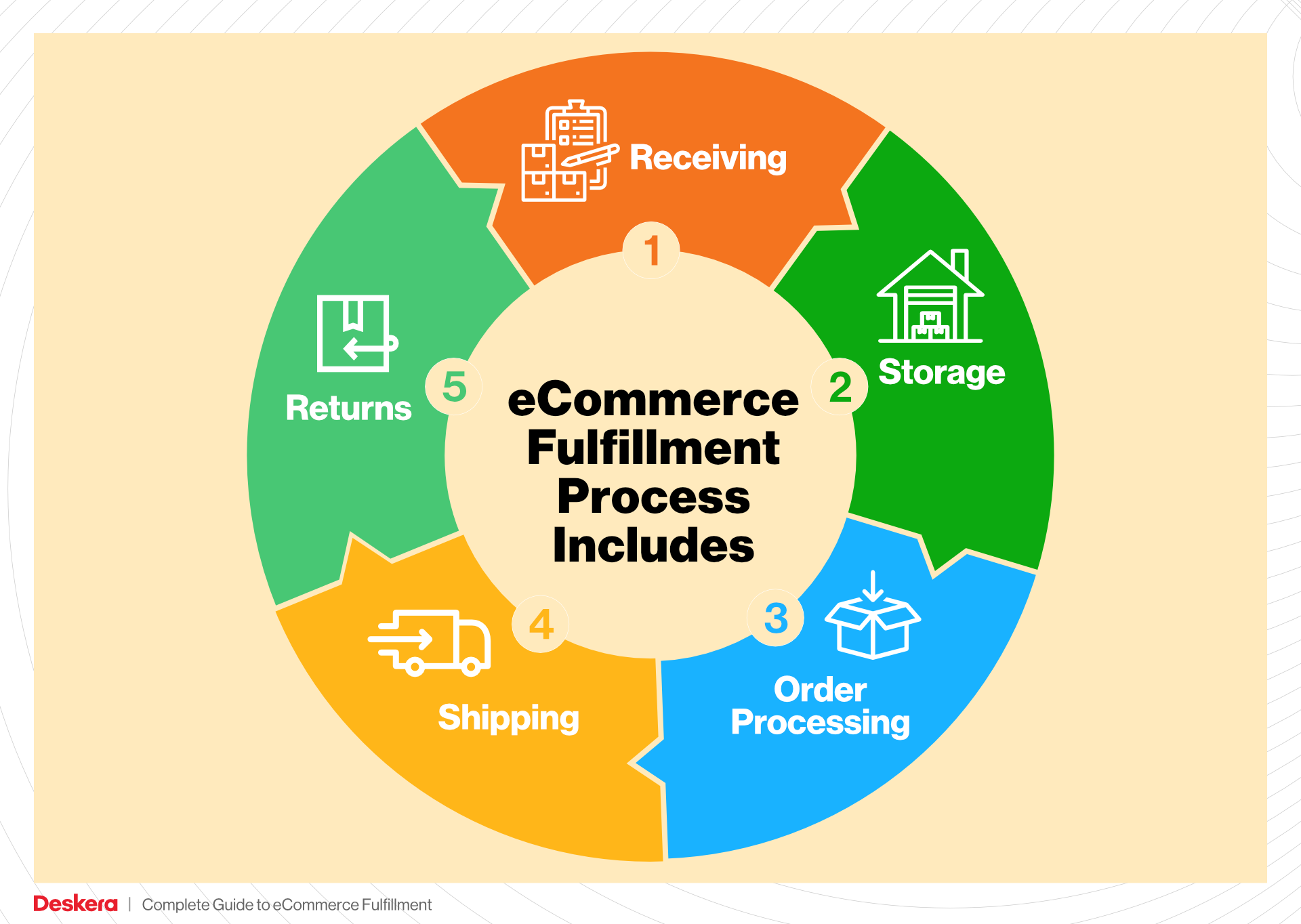
What You’ll Learn In This Guide
- What is E-commerce Fulfillment? An Introduction for Growing Businesses
- The Order Fulfillment Process: From ‘Buy’ Button to Customer’s Door
- Comparing Fulfillment Models: In-House vs. 3PL vs. Dropshipping
- A Deep Dive into Amazon FBA: Pros, Cons, and Who It’s For
- Core Services Offered by Fulfillment Centers
- How to Choose a Fulfillment Partner: A 6-Point Checklist
- Understanding Fulfillment Pricing: A Breakdown of Common Fees
- Frequently Asked Questions (FAQs) about Fulfillment
- Conclusion: Is Outsourcing Fulfillment the Right Move for Your Business?
- Important Disclaimer
The Order Fulfillment Process: From ‘Buy’ Button to Customer’s Door
1. Receiving Inventory
The order fulfillment process begins with the receiving of inventory, where products are delivered to the warehouse from suppliers or manufacturers. Upon arrival, the inventory is checked against the purchase order to ensure accuracy in quantities and product specifications. This step is crucial as it sets the foundation for the entire fulfillment process. Any discrepancies at this stage can lead to issues downstream, including stockouts or incorrect shipments.
Key Term: SKU (Stock Keeping Unit)
Each product should be assigned a unique SKU, which aids in tracking and managing inventory levels effectively. Accurate receiving ensures that all SKUs are accounted for, maintaining inventory integrity and facilitating smooth operations later on.
2. Warehouse Storage
After inventory is received and verified, the next step is warehouse storage. Products are organized within the warehouse according to a systematic layout that maximizes space and efficiency. This organization can involve using shelving, bins, or pallets depending on the size and nature of the products.
Proper storage is vital as it directly impacts order picking speed and accuracy. A well-organized warehouse minimizes the time staff spend locating products, which is essential for maintaining customer satisfaction through timely deliveries.
Key Term: Location Codes
Implementing location codes for each storage area helps in quickly identifying where products are stored. This aids in inventory management and supports efficient retrieval during the picking process.
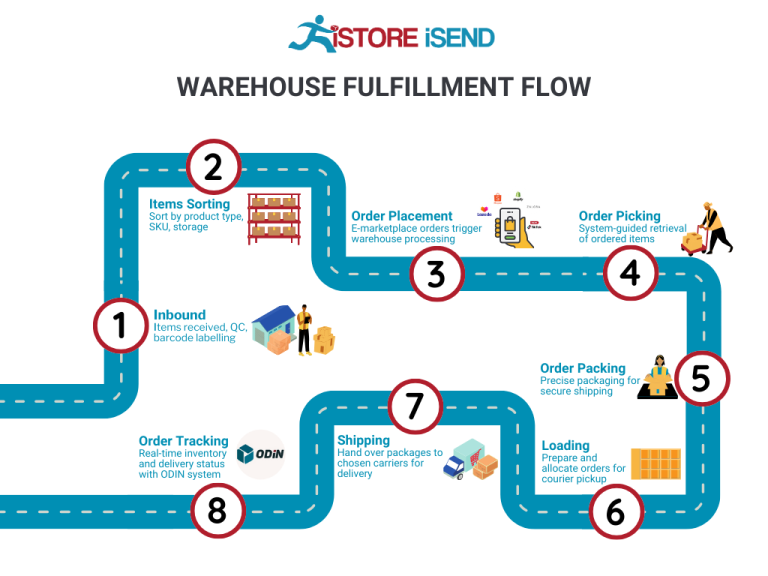
3. Order Picking
Once an order is placed, the order picking process is initiated. Warehouse staff utilize pick lists—documents that detail which items to retrieve and their respective locations in the warehouse. The goal during this phase is to gather the correct items efficiently and accurately.
This step is crucial because errors in picking can lead to customer dissatisfaction, returns, and increased operational costs. Efficient picking processes can significantly enhance fulfillment speed and accuracy, ensuring that customers receive the right products on time.
Key Term: Batch Picking
For high-volume orders, batch picking can be utilized, where multiple orders are picked simultaneously. This method can streamline operations and reduce the time spent on picking, ultimately leading to faster order processing.
4. Order Packing
After items have been picked, they move to the order packing stage. Here, products are carefully packed into boxes or envelopes, often with protective materials to prevent damage during transit. The packing process also includes labeling the packages with shipping information and any necessary documentation.
Effective packing is crucial for minimizing damage during shipping and ensuring that the correct items are sent to customers. This step also serves as a final check for order accuracy, as staff can verify that the right items are included before sealing the package.
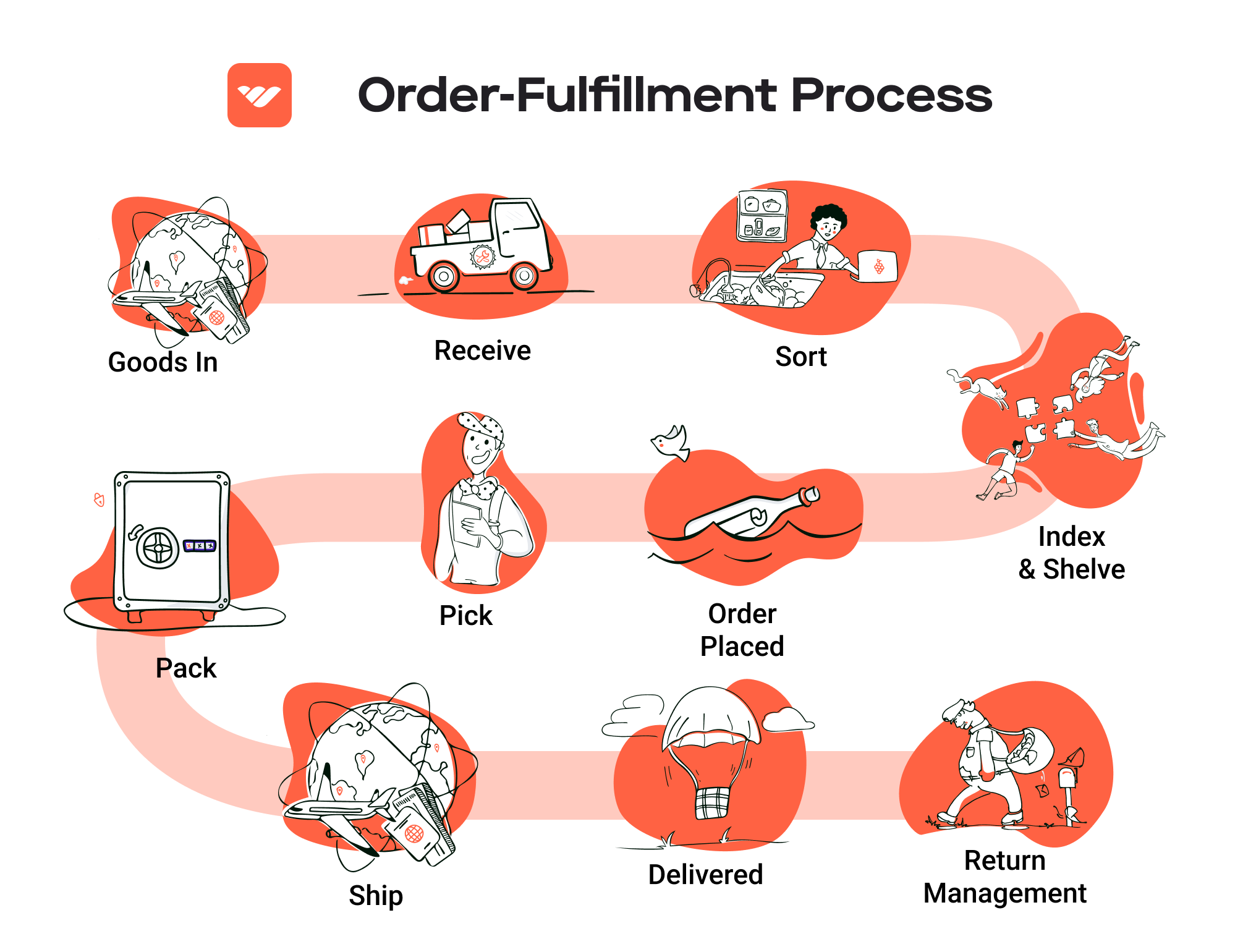
Key Term: Packing Slips
A packing slip is included in the package, detailing the contents of the order. This not only helps customers verify their purchases but also serves as a reference for returns or exchanges.
5. Shipping & Delivery
The final step in the order fulfillment process is shipping and delivery. Once packed, orders are handed over to shipping carriers for delivery to the customer’s address. This stage involves selecting the most efficient shipping methods based on speed, cost, and destination.
This step is critical because it directly affects customer satisfaction. Fast and reliable shipping can enhance the customer experience and encourage repeat business. Businesses should strive to offer multiple shipping options to cater to different customer preferences.
Key Term: Transit Times
Understanding transit times—how long it takes for a package to reach its destination—is essential for setting customer expectations. By optimizing shipping routes and methods, businesses can improve delivery speed and reliability.
In conclusion, mastering the order fulfillment process is essential for e-commerce businesses looking to scale. Each step—from receiving inventory to shipping and delivery—plays a significant role in ensuring customer satisfaction and operational efficiency. By focusing on these key areas and implementing best practices, businesses can enhance their fulfillment capabilities and drive growth.
Comparing Fulfillment Models: In-House vs. 3PL vs. Dropshipping
Fulfillment Model Comparison
| Model | Who Handles Inventory | Best For (Business Stage) | Key Advantage | Key Disadvantage |
|---|---|---|---|---|
| In-House Fulfillment | Business itself | Startups and established brands | Full control over inventory and processes | High operational costs and complexity |
| Third-Party Logistics (3PL) | Third-party provider | Growing brands with scaling needs | Expertise, scalability, and efficiency | Less control over inventory and processes |
| Dropshipping | Supplier | New or low-volume businesses | Low startup costs and inventory risk | Lower profit margins and longer shipping times |
In-House Fulfillment
In-house fulfillment refers to a model where the e-commerce business manages its own warehousing, inventory management, and shipping processes. This approach is often favored by startups and established brands that want complete control over their operations. One of the main advantages of in-house fulfillment is the ability to customize every aspect of the fulfillment process. Businesses can implement their own quality control measures, optimize packing processes, and maintain direct oversight of inventory levels and customer service. However, the downsides are significant. Managing fulfillment in-house can lead to high operational costs, especially as the business scales. The need for physical space, labor, and technology investments can quickly add up, and as order volumes increase, so does the complexity of logistics. Additionally, companies must be prepared to handle fluctuations in demand, which can strain resources and impact service quality.
Third-Party Logistics (3PL)
Third-party logistics (3PL) providers, like Red Stag Fulfillment, offer outsourced warehousing and fulfillment services for e-commerce businesses. This model is ideal for growing brands that are looking to scale their operations without the burden of managing logistics internally. A key advantage of partnering with a 3PL is access to their expertise in logistics, which can lead to improved efficiency and reduced shipping times. For example, Red Stag Fulfillment specializes in handling large, heavy, and bulky items and guarantees high accuracy and on-time shipping, which can significantly enhance customer satisfaction. 3PLs typically offer a range of services, including inventory management, returns handling, and integration with major e-commerce platforms, allowing businesses to focus on growth rather than logistics. However, outsourcing fulfillment means relinquishing some control over inventory and processes. Businesses may encounter challenges in communication and responsiveness, especially if the 3PL does not align with their operational needs or customer service standards.
Dropshipping
Dropshipping is a fulfillment model where the retailer does not keep goods in stock but instead transfers customer orders and shipment details directly to a supplier, who then ships the products to the customer. This model is particularly suitable for new or low-volume businesses that want to minimize upfront costs and inventory risks. The primary advantage of dropshipping is that it requires very little capital investment. Retailers can offer a wide range of products without the need to purchase inventory upfront, making it an attractive option for entrepreneurs testing new markets or product lines. However, dropshipping has its drawbacks. Profit margins can be lower compared to in-house or 3PL models due to the reliance on suppliers who often dictate pricing. Additionally, shipping times can be longer, especially if the supplier is located overseas, which may lead to customer dissatisfaction. The retailer also has limited control over product quality and fulfillment processes, which can negatively impact brand reputation if issues arise.
In conclusion, the choice between in-house fulfillment, 3PL, and dropshipping ultimately depends on a business’s current stage, resources, and growth objectives. Each model presents unique advantages and challenges that require careful consideration to align with the company’s strategic goals and customer service standards.
A Deep Dive into Amazon FBA: Pros, Cons, and Who It’s For
Understanding Fulfillment by Amazon (FBA)
Fulfillment by Amazon (FBA) is a service offered by Amazon that allows sellers to store their products in Amazon’s fulfillment centers. Amazon then takes care of the storage, packaging, shipping, and customer service for these products. This means that when a customer orders a product listed under FBA, Amazon handles the entire fulfillment process, ensuring a streamlined experience for both the seller and the buyer.
How FBA Works
-
Set Up: Sellers create an Amazon Seller account and enroll their products in the FBA program. They can either ship products directly to Amazon’s fulfillment centers or use Amazon’s partnered carriers to facilitate logistics.
-
Storage: Once received at the fulfillment center, products are stored until sold. Amazon manages the inventory, and sellers can track their stock levels through the Amazon Seller Central dashboard.
-
Order Fulfillment: When a customer places an order for an FBA product, Amazon automatically picks, packs, and ships the item on behalf of the seller. This process is rapid, often resulting in same-day or next-day shipping.
-
Customer Service: Amazon also handles customer service and returns for FBA products, allowing sellers to focus more on other aspects of their business.
-
Payment: Sellers receive payments for their sales, minus Amazon’s fees, which vary based on the size and weight of the product.
Pros of Fulfillment by Amazon
-
Prime Eligibility: Products fulfilled by Amazon are automatically eligible for Amazon Prime, which can significantly increase visibility and sales. Prime members often prefer purchasing items that can be delivered quickly, enhancing the likelihood of conversions.
-
Customer Trust: Amazon is a well-established brand with a reputation for reliability. By using FBA, sellers can leverage this trust, as customers are more likely to purchase items that are backed by Amazon’s customer service and return policies.
-
Multi-Channel Fulfillment: FBA allows sellers to fulfill orders from multiple sales channels, not just Amazon. This means sellers can integrate FBA with their own e-commerce sites or other marketplaces, streamlining logistics and inventory management.
-
Scalability: FBA can accommodate growth without requiring sellers to invest in their own warehousing and fulfillment operations. As sales increase, Amazon’s infrastructure can support higher volumes seamlessly.
-
Time Savings: By outsourcing fulfillment to Amazon, sellers can save significant time on logistics, allowing them to focus on product development, marketing, and other business growth strategies.
Cons of Fulfillment by Amazon
-
High Fees: FBA comes with various fees, including storage fees, fulfillment fees, and long-term storage fees for products that don’t sell quickly. These costs can eat into profit margins, especially for lower-priced items.
-
Strict Inventory Rules: Amazon has stringent policies regarding inventory management. Sellers must adhere to specific guidelines, including labeling requirements and restrictions on certain products. Non-compliance can lead to additional charges or even account suspension.
-
Commingling Risks: When using FBA, sellers’ products may be commingled with products from other sellers, which can lead to issues such as mis-picks or counterfeit items being sent to customers. This poses risks to brand reputation and customer satisfaction.
-
Limited Control: Sellers relinquish control over the fulfillment process, which can be problematic if issues arise. For example, if a product is damaged in storage or an order is mis-shipped, the seller may have limited recourse.
-
Inventory Management Complexity: While Amazon handles fulfillment, sellers still need to manage their inventory levels across multiple platforms. This can create complexity, particularly for businesses that sell through various channels.
Who is FBA Best For?
Fulfillment by Amazon is ideal for:
-
Small to Medium-Sized Businesses: Companies looking to scale quickly without the burden of managing logistics can benefit significantly from FBA. The service allows them to focus on marketing and product development while Amazon handles fulfillment.
-
Sellers with High Turnover Products: Businesses that sell items with a high turnover rate can maximize their profit margins by using FBA, as they can take advantage of the quick shipping and customer trust associated with Amazon.
-
Brands Looking to Enhance Visibility: Sellers aiming to reach a broader audience and gain Prime eligibility will find FBA beneficial, as it can dramatically increase product visibility and sales.
-
Entrepreneurs Testing New Products: FBA provides a low-risk way for entrepreneurs to test new products without committing to a full-fledged logistics operation.
In conclusion, Fulfillment by Amazon offers a robust solution for e-commerce sellers looking to streamline their logistics and leverage Amazon’s vast infrastructure. However, it’s crucial for potential users to weigh the pros and cons carefully, considering their specific business needs and growth strategies. For many, the benefits of FBA, particularly in terms of scalability and customer trust, can significantly outweigh the challenges.
Core Services Offered by Fulfillment Centers
Inventory Management & Warehousing
Effective inventory management is the backbone of any successful e-commerce operation. Fulfillment centers provide specialized warehousing services that allow businesses to store their products in secure, organized environments. This includes receiving shipments, tracking inventory levels, and ensuring that products are readily available for order fulfillment.
The benefits of utilizing a fulfillment center for inventory management are manifold. First, these centers employ advanced technology to monitor stock levels in real-time, which reduces the risk of stockouts or overstock situations. This precision not only enhances customer satisfaction—by ensuring products are available when needed—but also optimizes cash flow management. Businesses can make informed purchasing decisions based on accurate data, thus minimizing excess inventory costs.
Moreover, fulfillment centers often have strategic warehouse locations that enable faster shipping times. For instance, Red Stag Fulfillment, with its warehouses in Salt Lake City and Sweetwater, allows brands to reach 96% of the U.S. population within two days. This capability is crucial for e-commerce businesses aiming to enhance their delivery speed and overall customer experience.
Pick and Pack Services
Pick and pack services are a critical component of the order fulfillment process. This service entails selecting (picking) the correct items from the warehouse and then packaging (packing) them for shipment. Fulfillment centers like Red Stag Fulfillment have streamlined systems in place to ensure that this process is both efficient and accurate.
The primary advantage of outsourcing pick and pack services is the significant reduction in operational complexity for e-commerce businesses. By entrusting this task to fulfillment centers, companies can focus on core activities such as marketing and product development. Moreover, fulfillment centers typically achieve high accuracy rates, as evidenced by Red Stag’s impressive 99.99% fulfillment accuracy, which minimizes the risk of shipping errors that can lead to costly returns and unhappy customers.
Additionally, many fulfillment centers offer same-day shipping services, which can be a game-changer for businesses needing to meet tight deadlines or respond to sudden spikes in demand. This agility not only boosts customer satisfaction but also enhances the brand’s reputation for reliability.
Kitting and Assembly
Kitting and assembly services involve the grouping of individual items into ready-to-ship sets or kits. This service is particularly valuable for businesses that sell products requiring assembly or those that offer bundled items. Fulfillment centers can manage this process efficiently, ensuring that all components are included and packaged correctly.
The benefits of kitting and assembly services are significant. For one, they simplify the order fulfillment process by allowing businesses to ship products as complete sets rather than individual items. This can lead to reduced shipping costs and improved customer satisfaction, as customers receive everything they need in a single package.
Moreover, kitting can enhance marketing opportunities. Businesses can create special offers or themed bundles that appeal to specific customer segments, encouraging larger purchases. For example, a kitchenware company could bundle a pot, pan, and utensil set into a single kit, making it more appealing for customers looking to outfit their kitchen.
Returns Management (Reverse Logistics)
Returns management, or reverse logistics, is a crucial service provided by fulfillment centers. This process involves handling product returns from customers, which can be a complex and resource-intensive task for e-commerce businesses. Fulfillment centers offer streamlined processes for receiving, inspecting, and restocking returned items.
The primary benefit of effective returns management is the enhancement of customer trust and satisfaction. A smooth returns process encourages customers to make purchases, knowing that they have the option to return items if they are not satisfied. This can significantly reduce cart abandonment rates, as consumers are more likely to complete a purchase when they feel secure in their return options.
Furthermore, fulfillment centers can analyze return data to identify trends and reasons for returns. This information is invaluable for e-commerce businesses looking to improve product quality or customer experience. By understanding why items are returned, businesses can make data-driven decisions to enhance their offerings, ultimately leading to reduced return rates and increased profitability.
In conclusion, the core services offered by fulfillment centers—inventory management and warehousing, pick and pack services, kitting and assembly, and returns management—are essential for e-commerce businesses looking to scale efficiently. By leveraging these services, companies can optimize their operations, enhance customer satisfaction, and focus on strategic growth initiatives.
How to Choose a Fulfillment Partner: A 6-Point Checklist
Location & Warehouse Network
The geographical location of your fulfillment partner plays a crucial role in your logistics strategy. A well-positioned warehouse network can significantly reduce shipping times and costs.
Why It Matters:
– Shipping Speed: Proximity to major markets allows for quicker delivery times.
– Cost Efficiency: Lower shipping zones can lead to reduced shipping costs, enhancing your profitability.
Questions to Ask:
– What are your warehouse locations, and how do they support my target markets?
– How do you optimize shipping routes to ensure timely deliveries?
– What percentage of the U.S. population can you reach within 1-2 days?
Technology & Integrations
In today’s digital landscape, technology is a key enabler of efficient fulfillment operations. A robust technology platform can streamline your operations, from inventory management to order processing.
Why It Matters:
– Real-Time Tracking: Advanced systems provide real-time visibility into inventory and shipments, enhancing customer satisfaction.
– Seamless Integration: Ability to connect with your existing e-commerce platforms and marketplaces ensures smooth operations.
Questions to Ask:
– What technology stack do you use for inventory management and order fulfillment?
– Can your system integrate with my e-commerce platform (e.g., Shopify, Amazon)?
– Do you offer APIs for custom integrations, and how user-friendly are they?
Specializations (e.g., Cold Storage, Oversized Items)
Different businesses have unique needs, especially when it comes to the type of products they sell. Your fulfillment partner should have the necessary expertise to handle your specific requirements.
Why It Matters:
– Product Compatibility: Ensures that your products are stored and handled correctly, minimizing damage and returns.
– Special Handling Capabilities: Some products require specialized storage conditions, like temperature control for perishables.
Questions to Ask:
– What types of products do you specialize in, and do you have experience with my specific product category?
– Can you accommodate special handling requirements, such as cold storage or oversized items?
– What value-added services do you provide (e.g., kitting, assembly)?
Scalability & Capacity
As your business grows, your fulfillment partner should be able to scale operations accordingly. A partner that can’t keep up with your growth can lead to operational bottlenecks and customer dissatisfaction.
Why It Matters:
– Future-Proofing: A scalable partner can adapt to your changing needs without disrupting service.
– Capacity Management: Understanding their capacity helps ensure they can handle peak seasons and surges in demand.
Questions to Ask:
– What is your current capacity, and how quickly can you scale operations if my order volume increases?
– How do you manage capacity during peak seasons, and what are your contingency plans?
– Can you provide case studies or examples of how you’ve supported growing brands in the past?
Pricing and Contracts
Understanding the pricing structure and contract terms is essential for maintaining profitability. A transparent pricing model allows you to accurately forecast costs and budget accordingly.
Why It Matters:
– Cost Control: Hidden fees can erode your margins; clear pricing helps in budgeting.
– Flexibility: Contract terms should allow for growth and changes in your business model without incurring penalties.
Questions to Ask:
– What is your pricing structure, and are there any additional fees I should be aware of (e.g., for storage, returns)?
– How do you handle contract renewals and price adjustments?
– Are there options for trial periods or flexible contracts if my needs change?
Customer Support & Reviews
Exceptional customer support can be the differentiator between a good and a great fulfillment partner. You need a partner who is responsive and supportive, especially when issues arise.
Why It Matters:
– Problem Resolution: Quick and effective customer service can minimize disruptions and enhance your operational efficiency.
– Reputation Insight: Reviews and testimonials from other clients provide valuable insight into the partner’s reliability and service quality.
Questions to Ask:
– What customer support options do you offer (e.g., phone, email, chat), and what are your response times?
– Can you provide references or case studies from clients in my industry?
– How do you handle issues or disputes that may arise during the fulfillment process?
Conclusion
Choosing the right fulfillment partner is a critical decision that can significantly impact your e-commerce business’s success. By evaluating potential partners against this checklist, you can ensure that you select a fulfillment solution that aligns with your business goals and enhances your operational efficiency. Taking the time to thoroughly assess these factors will pay dividends as you scale your business.
Understanding Fulfillment Pricing: A Breakdown of Common Fees
Initial Setup Fees
Initial setup fees are one-time costs associated with onboarding your business to a fulfillment center. These fees can include the integration of your e-commerce platform with the fulfillment provider’s system, configuring inventory management tools, and any necessary training for your team on how to utilize the fulfillment services effectively.
The calculation of these fees varies by provider and can depend on the complexity of your operations. For example, if you require custom software integration or advanced reporting features, your setup fees may be higher. To manage these costs, it’s advisable to clarify what is included in the setup fee and ensure that there are no hidden charges. Some fulfillment companies, like Red Stag Fulfillment, may offer customized quotes based on your specific needs, which can help mitigate unexpected expenses.
Receiving Fees
Receiving fees are charged when your inventory arrives at the fulfillment center. These fees cover the costs associated with unloading, inspecting, and cataloging your products into the warehouse system. The pricing structure for receiving fees is often based on the volume of inventory received, typically calculated per pallet or per item.
In practice, if you’re sending large shipments, the receiving fee may be lower per unit compared to smaller shipments. It’s essential to consider the timing of your shipments and the frequency to optimize these costs. Some fulfillment centers may also charge additional fees for expedited receiving or for processing damaged goods, so understanding the full scope of these charges is crucial.
Storage Fees (per pallet/bin)
Storage fees are recurring charges for keeping your products in the fulfillment center’s warehouse. These fees are generally calculated based on the amount of space your inventory occupies, typically measured in pallets or bins. The cost can vary significantly based on the location of the warehouse and the type of products stored.
For instance, larger or bulkier items may incur higher storage fees compared to smaller items due to the space they occupy. Additionally, some providers may offer tiered pricing based on the volume of goods stored, which can provide cost savings for businesses with higher inventory levels. To optimize storage fees, consider conducting regular inventory assessments to avoid overstocking and to maintain a lean inventory strategy.
Pick & Pack Fees (per item/order)
Pick and pack fees are charged for the labor involved in retrieving items from storage, packaging them, and preparing them for shipment. These fees are typically calculated per item or per order, depending on the fulfillment provider’s pricing structure.
For example, if an order consists of multiple items, the pick fee may be multiplied by the number of items picked, while the pack fee may apply as a flat rate per order. This pricing model incentivizes businesses to streamline their order processing by consolidating items into fewer orders whenever possible. To minimize these costs, it’s beneficial to analyze order patterns and consider bulk orders or bundled products that can reduce the number of individual picks required.
Shipping Fees
Shipping fees are the charges associated with sending your products from the fulfillment center to the end customer. These costs can vary widely based on several factors, including the shipping method (ground, air, etc.), the distance to the delivery location, and the weight and dimensions of the package.
Many fulfillment centers negotiate shipping rates with carriers, which can lead to savings for businesses, especially for those with high shipping volumes. Understanding the shipping zones and how they affect costs is crucial; providers like Red Stag Fulfillment utilize strategic warehouse locations to reduce shipping distances and costs. To further manage shipping expenses, consider utilizing flat-rate shipping options or partnering with a fulfillment provider that offers discounted shipping rates.
Tips for Getting an Accurate Quote
-
Be Transparent: Provide detailed information about your inventory, including dimensions, weights, and SKU counts. The more accurate your data, the more precise the quote will be.
-
Clarify Services: Ensure you understand what is included in the quote. Some providers may have additional fees for services like returns management or kitting, which can impact your overall costs.
-
Request Custom Quotes: Many fulfillment centers, such as Red Stag Fulfillment, offer custom quotes based on your specific needs. This approach can help you avoid unexpected costs associated with standardized pricing models.
-
Compare Multiple Providers: Obtain quotes from several fulfillment centers to compare not only pricing but also service offerings and guarantees. This will help you find a provider that aligns with your operational needs and budget.
-
Negotiate: Don’t hesitate to negotiate terms, especially if you anticipate high shipping volumes or long-term partnership potential. Many fulfillment companies are open to adjusting their fees to secure your business.
By understanding these common fulfillment pricing models and following these tips, you can make informed decisions that enhance your logistics strategy and support your business growth.
Frequently Asked Questions (FAQs) about Fulfillment
1. What is Red Stag Fulfillment?
Red Stag Fulfillment is a third-party logistics (3PL) provider specializing in e-commerce fulfillment for fast-growing and enterprise brands. They offer services that include order processing, inventory management, shipping, and returns management, with a focus on high accuracy and efficiency.
2. What is a 3PL?
A third-party logistics provider (3PL) is a company that offers outsourced logistics services, which encompass a variety of operations including warehousing, inventory management, order fulfillment, and transportation. Utilizing a 3PL allows businesses to streamline their supply chain, reduce costs, and focus on core competencies.
3. How does Red Stag Fulfillment ensure accuracy?
Red Stag Fulfillment boasts an impressive 99.99% fulfillment accuracy rate. They achieve this through rigorous inventory management practices, advanced technology, and a dedicated team that understands the importance of accuracy in fulfillment operations. Their performance metrics include thorough checks at each step of the fulfillment process.
4. What types of products can be fulfilled by Red Stag?
Red Stag Fulfillment specializes in handling big, heavy, and bulky items, making them ideal for businesses with such products. They also cater to a wide range of industries, including e-commerce, direct-to-consumer (DTC), and retail, ensuring that various product types can be efficiently managed.
5. How much do fulfillment services cost?
The cost of fulfillment services varies based on factors such as order volume, product type, storage needs, and additional services required (like kitting or returns management). Red Stag Fulfillment provides custom quotes based on specific business needs, ensuring transparency and alignment with your budget.
6. What’s the difference between a warehouse and a fulfillment center?
While both warehouses and fulfillment centers store products, a fulfillment center is specifically designed to manage the entire order fulfillment process. This includes picking, packing, and shipping orders directly to customers. In contrast, a warehouse primarily focuses on inventory storage without necessarily handling the logistics of order fulfillment.
7. How quickly can Red Stag Fulfillment ship orders?
Red Stag Fulfillment offers same-day shipping and can reach 96% of the U.S. population within two days via ground shipping. Their strategically located warehouses in Salt Lake City, UT, and Sweetwater, TN, facilitate efficient delivery to a broad customer base.
8. What guarantees does Red Stag Fulfillment offer?
Red Stag Fulfillment provides several industry-leading guarantees to protect your business, including a No Shrinkage Guarantee (no lost or damaged inventory), Accuracy Guarantee (correct items shipped), Shipping Guarantee (on-time order dispatch), and Receiving Guarantee (fast processing of inbound shipments).
9. How can I integrate Red Stag Fulfillment with my e-commerce platform?
Red Stag Fulfillment seamlessly integrates with all major e-commerce platforms, such as Shopify, Amazon, and Walmart. For businesses with unique needs, they also offer custom API integration to ensure smooth synchronization between your online store and their fulfillment system.
10. What should I consider when choosing a fulfillment partner?
When selecting a fulfillment partner, consider factors such as their specialization in your product type, accuracy and reliability metrics, shipping capabilities, customer service responsiveness, and pricing structure. It’s also essential to evaluate their technology and integration capabilities to ensure compatibility with your existing systems.
Conclusion: Is Outsourcing Fulfillment the Right Move for Your Business?
Evaluating the Benefits of Outsourcing Fulfillment
Outsourcing your fulfillment operations can be a transformative decision for your e-commerce business. By leveraging a dedicated fulfillment partner, you can save significant time, allowing you to focus on strategic growth initiatives rather than day-to-day logistics. Many business owners report a drastic reduction in the hours spent managing fulfillment—from over ten hours a week to just one—freeing up valuable resources for marketing, product development, and customer engagement.
Scalability is another compelling reason to consider outsourcing. As your business grows, so too do the complexities of inventory management, order processing, and shipping logistics. A reputable fulfillment partner can seamlessly adjust to your changing needs, providing the infrastructure and support necessary to handle fluctuations in demand—whether it’s a seasonal surge or a sudden increase in product launches. This flexibility allows you to scale without the associated headaches of managing additional warehousing or staffing.
Additionally, partnering with a fulfillment expert means tapping into a wealth of industry knowledge and technology. A dedicated third-party logistics provider (3PL) like Red Stag Fulfillment brings not only state-of-the-art systems for inventory management and tracking but also expertise in optimizing shipping routes and minimizing costs. This can lead to improved customer satisfaction, with faster and more reliable delivery times.
However, it is crucial to choose the right fulfillment partner. Your success hinges on their ability to align with your business goals and deliver consistent results. Take the time to evaluate your current fulfillment processes and assess whether an outsourcing solution could enhance your operational efficiency and customer experience.
Call to Action
To determine if a fulfillment partner is the right next step for your business, conduct a thorough audit of your current shipping process. Analyze your operational pain points, cost structures, and customer feedback. This assessment will help you make an informed decision about whether outsourcing fulfillment can drive growth and efficiency in your e-commerce operations.
Important Disclaimer
⚠️ Important Disclaimer
The information in this guide is for educational purposes. Fulfillment services, pricing, and platform features change frequently. Always conduct your own due diligence and consult with providers directly before making business decisions.
